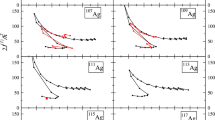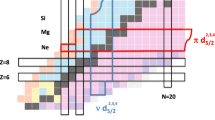Summary
The energy levels of nuclei in the shells 1p 3/2, 1d 3/2 and 2p 3/2 are described by a group-theoretical mass formula deduced from the hypothesis of pure (j)n configurations in the seniority scheme. The residual interaction between nucleons is decomposed into the pairing term (J=0,T=1), the isopairing term (J=odd,T=0) and aJ≠0,T=1 term; Coulomb interaction between protons is accounted for in a schematic way. The corresponding coupling constants, together with single-particle energies, are treated as free parameters to be adjusted by a least-square fit to experimental data. Deviations between experimental and calculated energies are analysed in order to test the validity of the proposed symmetry scheme in the three shells considered, and to discuss its possible improvements.
Riassunto
I livelli energetici dei nuclei degli strati 1p 3/2, 1d 3/2 e 2p 3/2 sono stati descritti con una formula di massa dedotta con metodi gruppali dall’ipotesi di pura configurazione (j)n nello schema di seniorità. L’interazione residua tra nucleoni è divisa nel termine di « pairing » (J=0,T=1), quello di « isopairing » (J=dispari,T=0) e il termine inJ≠0,T=1; l’interazione coulombiana tra protoni è stata introdotta in forma schematica. Le corrispondenti costanti di accoppiamento, e le energie di singola particella, sono state trattate come parametri variazionali per ottimizzare l’accordo con i dati sperimentali. Gli scarti tra le energie calcolate e quelle sperimentali sono stati analizzati per verificare la validità dello schema di simmetria proposto nei tre strati considerati e per discutere i suoi possibili miglioramenti.
Реэюме
Описываются уровни знергии ядер в оболочках 1p 3/2, 1d 3/2 и 2p 3/2 при помоши массовой формулы теории групп, выведенной иэ гипотеэы чистых (j)n конфигураций в схеме старщинства. Остаточное вэаимодействие между нуклонами раэлагается на член спаривания (J=0,T=1), член иэоспаривания (J=нечетное,T=0) и член сJ≠0,T=1; кулоновское вэаимодействие между протонами учитывается схематическим обраэом. Соответствуюшие константы свяэи, вместе с знергиями отдельных частиц, рассматриваются как свободные параметры, которые подгоняются посредством метода наименьщих квадратов к зкспериментальным данным. Аналиэируются отклонения между зкспериментальными и вычисленными знергиями, для того чтобы проверить справедливость предложенной схемы симметрии в трех рассмотренных оболочках и обсудить их воэможные улучщения.
Similar content being viewed by others
References
A. Goswami andL. Kisslinger:Phys. Rev.,140 B, 26 (1965);H. T. Chen andA. Goswami:Phys. Rev.,24 B, 257 (1967).
P. Camiz:Nuovo Cimento,50 B, 401 (1967).
P. Camiz:Proceedings of Herceg-Novi XII Lecture on Nuclear Many Body Problems (Belgrad, 1967), p. 271;Rendiconti S.I.F., Course XL (New York, 1969);Suppl. Nuovo Cimento,6, 689 (1968).
A. de Shalit andI. Talmi:Nuclear Shell Theory (New York, 1963), p. 451.
P. Camiz:Nuovo Cimento,51 B, 190 (1967);U. Cattani: Thesis, unpublished.
J. H. E. Mathauch, W. Thiele andA. H. Wapstra:Nucl. Phys.,67, 1 (1965).
F. Ajzenberg-Selove andT. Lauritsen:Nucl. Phys.,78, 1 (1966).
P. M. Endt andC. Van der Leun:Nucl. Phys., A105, 1 (1967).
Nuclear data B: vol. 2, n. 5 (1968) forA=59÷61 and vol.2, n. 3 (1967) for A=62÷64.
D. J. Sullivan andP. B. Treacy:Nucl. Phys.,78, 225 (1966).
R. G. Miller andR. W. Kavanagh:Nucl. Phys., A94, 261 (1967).
R. E. Berg, J. L. Snelgrove andE. Kashy:Phys. Rev.,153, 1165 (1967).
L. M. Blau, W. P. Alford, D. Cline andH. E. Gove:Nucl. Phys.,76, 45 (1966);J. Jänecke:Nucl. Phys.,48, 129 (1963).
M. Harcohl, A. A. Jaffe, C. H. Drory andJ. Zioni:Phys. Lett.,20, 303 (1966).
J. M. Freeman, J. H. Montague, G. Murray, R. G. White andW. E. Burcham:Nucl. Phys.,65, 113 (1965).
G. Racah andL. Farkas:Memorial Volume (Jerusalem, 1952), p. 294.
Author information
Authors and Affiliations
Additional information
The continuation of this research will be dedicated to his memory.
One of the authors (P.C.) wants to express his deep regret for the loss of his friend and collaboratorUmberto Cattani, who tragically died in the Alps, August 20th, 1969.
Rights and permissions
About this article
Cite this article
Camiz, P., Cattani, U. Group-theoretical analysis of nuclear states in somej=3/2 shells. Nuovo Cimento B (1965-1970) 64, 56–81 (1969). https://doi.org/10.1007/BF02710282
Received:
Published:
Issue Date:
DOI: https://doi.org/10.1007/BF02710282




